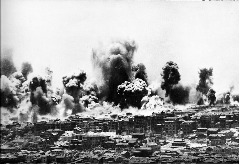Bombing of Chongqing
| Bombing of Chongqing | |||||
|---|---|---|---|---|---|
| Part of Second Sino-Japanese War | |||||
|
The city during bombing |
|||||
|
|||||
| Belligerents | |||||
|
(stationed October 1938) |
|
||||
| Commanders and leaders | |||||
|
Chiang Kai-shek Chen Cheng Liu Chih |
Prince Higashikuni Naruhiko Hajime Sugiyama Takijirō Ōnishi |
||||
| Casualties and losses | |||||
| 10,000+ civilian casualties 18,600 buildings destroyed and much of city center were damaged |
Dozens of fighters and bombers shot down | ||||
The bombing of Chongqing (simplified Chinese: 重庆大轰炸; traditional Chinese: 重慶大轟炸, Japanese: 重慶爆撃, from 18 February 1938 to 23 August 1943) was part of a terror bombing operation conducted by the Imperial Japanese Army Air Service and Imperial Japanese Navy Air Service on the Chinese provisional capital of Chongqing, authorized by the Imperial General Headquarters.
A total of 268 air raids were conducted against Chongqing, with more than 11,500, mainly incendiary, bombs dropped. The targets were usually residential areas, business areas, schools, hospitals and other non-military targets. These bombings were probably aimed at cowing the Chinese government, or as part of the planned Sichuan invasion.
In the first two days of the campaign, the raids of May 1939 killed more than five thousand Chinese civilians.
Two months later, after tens of thousands of deaths, in retaliation for firebombing, the United States embargoed the export of airplane parts to Japan, thus imposing its first economic sanction against that nation.
On 5 June 1941, the Japanese flew more than 20 sorties, bombing the city for three hours. About 4,000 residents who hid in a tunnel were asphyxiated.
The majority of the air raids conducted against Chongqing were made with squadrons of medium-heavy bombers composed of Mitsubishi G3Ms, known as "Nells" (under Allied codename), Ki-21s "Sallys", Fiat BR.20 Cicognas ("Ruths"), and Kawasaki Ki-48 "Lilys", although towards the end of the Second Sino-Japanese War/World War II, Mitsubishi G4M "Bettys", Ki-67 "Peggys", Nakajima Ki-49 "Helens", Yokosuka P1Y "Frances" were also deployed. Due to severe attrition of aircraft and veteran pilots of the initially equipped at the outbreak of the air war in 1937 with largely US-made aircraft and training (and training with Italian air force instructors), the Chinese Air Force increasingly relied on Soviet Union's assistance during the retreat and defense of Wuhan in 1938 and further retreat and defense of Chungking in 1939-41; Chinese pilots flying primarily the Polikarpov I-16 and I-15 series of fighter-pursuit aircraft in defense of Chongqing and Chengdu. The introduction of the Zero-sen fighter plane in 1940, the most advanced production fighter aircraft at the time, insured the Japanese practically total air supremacy.
...
Wikipedia

